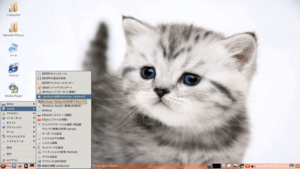Berry Linux
Berry Linux is a Live CD Linux distribution that has English and Japanese support. Berry Linux is based on and is compatible with Fedora 20 packages. The distribution is primarily focused on use as a Live CD, but it can also be installed to a live USB drive. Berry Linux can be used to try out and showcase Linux, for educational purposes, or as a rescue system, without the need to make changes to a hard disk. The current version is 1.31 released on 8 July 2019.[1][2][3]
 Berry Linux Live CD (version 1.17) | |
| Developer | Yuichiro Nakada |
|---|---|
| OS family | Unix-like |
| Working state | Current |
| Source model | Open source |
| Latest release | 1.32 / March 17, 2020 |
| Available in | English, Japanese |
| Package manager | RPM |
| Platforms | IA-32 |
| Kernel type | Monolithic kernel (Linux) |
| Default user interface | LXDE, Maynard |
| Official website | http://berry-lab.net/ |
Features
Berry includes read/write NTFS support, and AIGLX and Beryl are bundled for 3D desktop effects. Berry also uses bootsplash, giving it a graphical startup.[4]
The full version (v1.12) includes and runs on Linux Kernel 3.0.4. It has the ALSA sound system, ACPI support, and SELinux. Berry Linux features automatic hardware detection, with support for many graphics cards, sound cards, SCSI, USB devices and many other peripherals. Network devices are automatically configured with DHCP.
The full version of Berry Linux uses KDE (Version 4.6.5) while Berry Linux Mini uses the Fluxbox window manager. The full version is 512.7MB, while the mini version is 273.4MB. To test Berry Linux it is not necessary to install the distribution to a hard disk, as the operating system runs entirely from CD-ROM. It is, however, possible to install Berry Linux to a hard disk, which requires 1.7 gigabytes of free space. Supporting Japanese, Berry includes Whiz, a sharp Kana-Kanji conversion system. It also comes with LibreOffice version 3.4.3, a Microsoft Office compatible office suite, as well as TextMaker/PlanMaker as Berry's office software. The GIMP, version 2.6.10, is bundled for graphics software.
Berry includes the media players Audacious, MPlayer, Xine, and Kaffeine. DVD and DivX codecs are installed by default.
Version history
Berry Linux's historical releases are as following.
| Release Date | Version Number | Based on |
|---|---|---|
| 2003-11-11 | Berry Linux 0.29 | Fedora Core 1 |
| 2004-01-21 | Berry Linux 0.35 | Kernel 2.6 |
| 2004-07-21 | Berry Linux 0.43 | Fedora Core 2 |
| 2004-12-15 | Berry Linux 0.51 | Fedora Core 3 |
| 2005-07-21 | Berry Linux 0.60 | Fedora Core 4 |
| 2006-04-18 | Berry Linux 0.69 | Fedora Core 5 |
| 2006-11-20 | Berry Linux 0.76 | Fedora Core 6 |
| 2007-07-10 | Berry Linux 0.87 | Fedora 7 |
| 2008-02-24 | Berry Linux 0.88 | Fedora 8 |
| 2008-05-17 | Berry Linux 0.91 | Fedora 9 |
| 2008-12-07 | Berry Linux 0.94 | Fedora 10 |
| 2009-01-29 | Berry Linux 0.95 | Fedora 10 |
| 2009-04-10 | Berry Linux 0.96 | Fedora 10 |
| 2009-06-22 | Berry Linux 0.97 | Fedora 10 |
| 2009-09-14 | Berry Linux 0.98 | Fedora 11 |
| 2010-03-15 | Berry Linux 1.01 | Fedora 12 |
| 2010-08-31 | Berry Linux 1.04 | Fedora 13 |
| 2011-05-24 | Berry Linux 1.10 | Fedora 14 |
| 2011-10-30 | Berry Linux 1.12 | Fedora 15 |
| 2012-02-06 | Berry Linux 1.13 | Fedora 16 |
| 2012-05-28 | Berry Linux 1.14 | Fedora 16 |
| 2012-06-23 | Berry Linux 1.15 | Fedora 17 |
| 2012-12-31 | Berry Linux 1.17 | Fedora 17 |
| 2014-06-23 | Berry Linux 1.18 | Fedora 20 |
| 2015-01-08 | Berry Linux 1.19 | Fedora 21 |
| 2015-05-29 | Berry Linux 1.20 | Fedora 21 |
| 2015-11-22 | Berry Linux 1.21 | Fedora 23 |
| 2015-12-31 | Berry Linux 1.22 | Fedora 24 |
| 2017-01-08 | Berry Linux 1.24 | Fedora 25 |
| 2017-11-27 | Berry Linux 1.26 | Fedora 27 |
| 2019-07-08 | Berry Linux 1.31 | Fedora 30 |
| 2020-03-17 | Berry Linux 1.32 | Fedora 31 |
Trivia
The creator of the distribution is a well known cat lover.